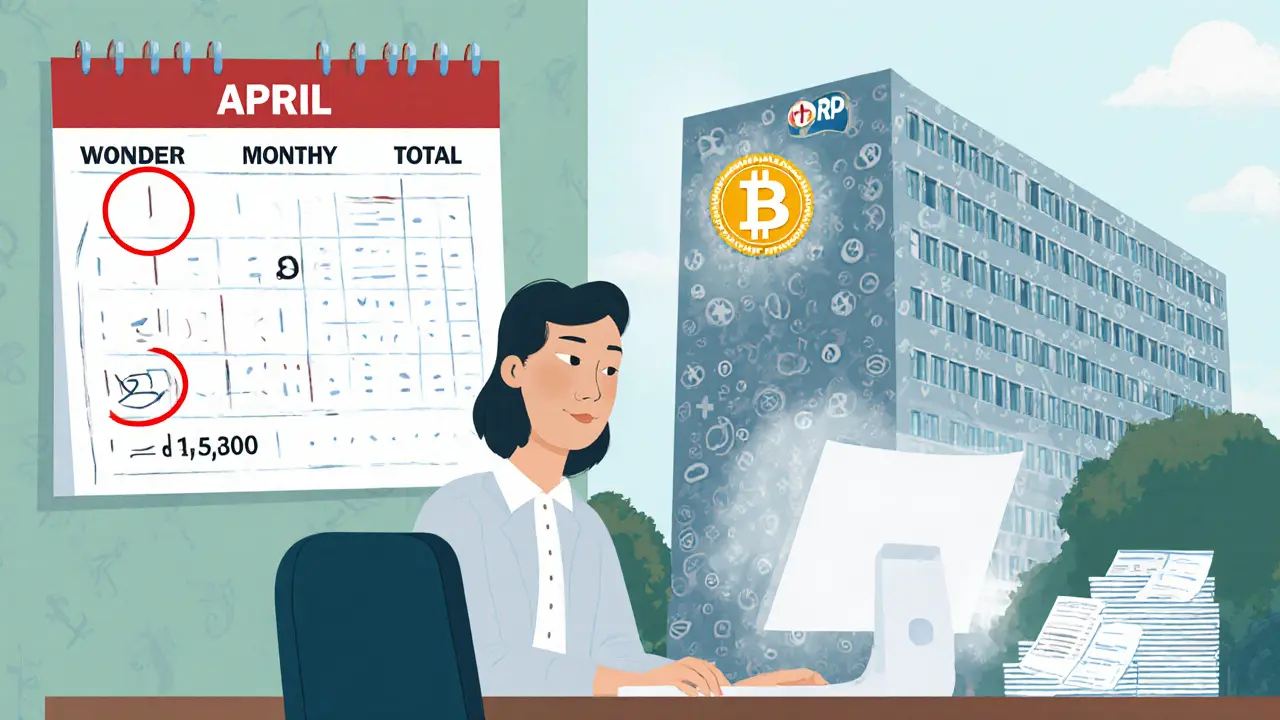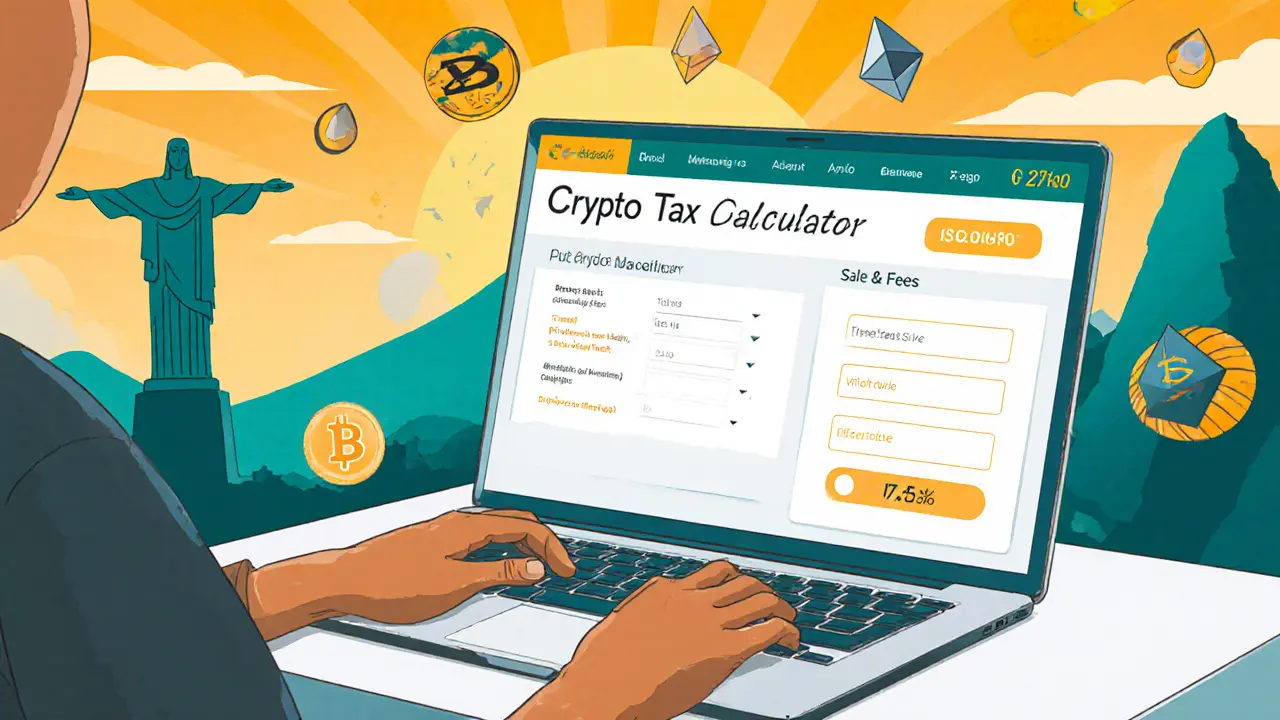Brazil Crypto Tax Calculator 2025
Calculate Your Taxable Gain
Tax Calculation Results
Enter values and click "Calculate Tax Liability" to see results.
Important Notes
- The tax rate is fixed at 17.5% for all crypto gains in Brazil as of June 12, 2025.
- This calculator assumes no other gains or losses in the same tax year.
- Losses can offset gains within the same tax year.
- Always consult a tax advisor for complex situations.
Brazil’s tax authority rolled out a Brazil cryptocurrency tax that catches almost everyone who trades, mines, or earns digital assets. Effective June 12, 2025, a flat 17.5% capital‑gains levy replaces the old, loophole‑filled regime. If you hold or move crypto in Brazil, you now have to log every transaction over BRL5,000 a month, file a detailed report on the eCac portal, and pay the tax by the April deadline of the following year. Below you’ll find everything you need to stay compliant, calculate your liability, and understand how the new rules reshape the market.
Quick Summary
- Flat 17.5% tax on all crypto gains - no short‑term vs. long‑term split.
- Reporting threshold: BRL5,000 in crypto transactions per month.
- Deadline: last business day of April for the previous fiscal year.
- All activities - selling, swapping, staking, mining, DeFi - are taxable.
- Penalties for late or inaccurate filings can reach 150% of the tax due.
What the 17.5% Flat Tax Means for You
Until mid‑2025 Brazil treated many crypto operations as tax‑free if they stayed below a modest annual threshold. The new rule, championed by Finance Minister Fernando Haddad, treats crypto the same way as stocks, bonds, or real‑estate. Whether you bought Bitcoin and held it for five years or day‑traded altcoins, the gain is taxed at a single 17.5% rate.
Receita Federal do Brasil (RFB) is the federal tax agency that now enforces crypto reporting and collection and requires disclosure of every crypto‑related activity that exceeds the monthly BRL5,000 limit.
The tax applies to:
- Conversion of crypto to Brazilian reais (BRL).
- Crypto‑to‑crypto swaps - the gain is measured by the fair market value of the received coin.
- Staking rewards, mining income, and DeFi yield.
- Gifts and airdrops when their fair market value exceeds the reporting threshold.
Reporting Requirements and Deadlines
Brazil’s fiscal year runs from January1 to December31. All crypto gains, losses, and incomes must be reported through the online portal eCac. The key dates are:
- Keep a running ledger of every transaction that pushes your monthly total over BRL5,000.
- By the last business day of April (usually April30), file a complete “Declaração de Ajuste Anual” including the crypto schedule.
- Pay the calculated 17.5% tax by the same deadline to avoid interest.
Failure to report or under‑reporting can trigger fines ranging from BRL500 to 150% of the tax owed, plus possible criminal investigations for fraud.
How to Calculate Your Crypto Capital Gains
Although the rate is flat, you still need to determine the taxable gain for each transaction. Follow these steps:
- Gather data: Export CSV statements from every exchange, wallet, and DeFi platform you used in the tax year.
- Convert to BRL: Use the official exchange rate published by the Central Bank of Brazil (Central Bank of Brazil (BCB) provides daily BRL/USD and BRL/Crypto reference rates) for the exact date and time of each trade.
- Determine cost basis: For each asset, the cost basis is the BRL amount you originally paid, including transaction fees.
- Calculate gain/loss: Subtract cost basis from the BRL proceeds of the sale or swap.
- Apply the 17.5% rate: Multiply the net gain by 0.175. Losses can offset gains within the same tax year.
- Report the total: Sum all gains and losses, then input the net amount on the eCac crypto schedule.
Many Brazilian traders use third‑party platforms like Koinly a crypto tax calculator that integrates with Brazilian exchanges and eCac to automate these steps.

Brazil vs. Other Crypto Tax Regimes
Brazil’s flat 17.5% lands it in the middle of global crypto tax rates. The table below shows how it stacks up against major markets as of 2025.
| Country | Rate | Holding‑Period Exemption | Reporting Threshold |
|---|---|---|---|
| Brazil | 17.5% flat | None - applies to all gains | BRL5,000 per month |
| Portugal | 28% on gains < 1 year, 0% after 1 year | 1‑year holding exemption | None - all gains taxed |
| Germany | 0% if held > 1 year, otherwise taxed at personal income rate | 1‑year exemption | €600 tax‑free allowance per year |
| United Kingdom | 10% or 20% (depending on income bracket) | £3,000 annual CGT allowance | None - all transactions must be reported |
| United States | 15%-37% based on taxable income | None - all gains taxed | None - all transactions reported to IRS |
Brazil’s policy eliminates the “short‑term vs. long‑term” split that Germany enjoys, but it is easier to predict than the tiered U.S. system.
Compliance Tips & Common Pitfalls
Staying on the right side of the RFB can feel like walking a tightrope, especially if you trade on multiple platforms. Here are proven shortcuts:
- Consolidate statements: Export CSV files from every exchange (e.g., Mercado Bitcoin, Binance Brazil, Kraken) and import them into a single spreadsheet or tax‑calculator tool.
- Use a dedicated wallet tracker: Apps that tag each transaction with the exact timestamp and BCB exchange rate reduce manual conversion errors.
- Document DeFi yields: Staking, liquidity mining, and yield‑farm rewards must be recorded at the moment they are credited, not when you later sell them.
- File early: The eCac portal experiences heavy traffic in March. Submitting before the deadline cuts stress and gives you time to correct any flagged errors.
- Keep receipts for fees: Exchange fees, withdrawal costs, and network gas fees are deductible from your cost basis.
- Seek professional advice for large portfolios: Tax advisors familiar with the Virtual Assets Act (Law 14,478/2022) Brazil’s legal framework governing crypto service providers can help you structure holdings to minimize exposure.
One frequent mistake is assuming that crypto‑to‑crypto swaps are tax‑free because no fiat is involved. The RFB treats the received coin’s fair market value as a taxable event, so you must record both sides of the trade.
Impact on Investors and the Market
From a retail perspective, the flat rate has sparked mixed feelings. On one hand, the certainty of a single 17.5% charge simplifies planning. On the other, the removal of exemptions means even a hobbyist who trades a few hundred reais a month now faces paperwork.
Professional traders tend to welcome the move. “Predictability is priceless,” says Robin Singh, CEO of Koinly. “When the tax rate is flat, you can price your strategies without worrying about tiered brackets.”
At a macro level, Brazil’s crypto market grew 24% in 2024, handling over $43.5billion in volume. The new tax is expected to generate billions in annual revenue, according to the Finance Ministry’s forecasts, but it may also slow the influx of new retail participants.
Regulators are also watching the broader ecosystem. The Central Bank of Brazil (BCB) is piloting a digital currency called Drex while tightening crypto tax rules, signalling an ambition to keep digital assets under tight fiscal control.
Future Outlook: What’s Next?
Brazil’s tax framework is still fresh, and a few potential developments could reshape it:
- Rate adjustments: If the market contracts, lawmakers may lower the 17.5% rate to stay competitive with regional peers.
- Higher thresholds: Pressure from retail groups could push the RFB to raise the BRL5,000 monthly reporting floor.
- Integration with Drex: A unified reporting system could allow crypto gains to be logged directly on a blockchain‑based ledger, simplifying compliance.
- Greater cross‑border cooperation: Brazil is part of a Latin American task force exploring common crypto‑tax guidelines, which might lead to a regional standard.
Until any changes land, the safest bet is to treat the current rules as permanent and build your tax strategy around them.
Frequently Asked Questions
Do I need to report crypto trades that stay below BRL5,000 a month?
No. The RFB only requires reporting when the sum of your crypto transactions in a given month exceeds BRL5,000. Below that, you can skip the crypto schedule, but you must still keep records in case of an audit.
How are staking rewards taxed?
Staking rewards are considered income at the moment they are credited. Their value in BRL, based on the BCB rate of that day, is added to your taxable income and then hit with the 17.5% capital‑gains rate.
Can I offset crypto losses against other capital gains?
Yes. Net crypto losses can be deducted from net crypto gains within the same fiscal year. They cannot be applied to non‑crypto capital gains or ordinary income.
What penalties apply for late filing?
Late filing incurs a fine of 0.33% per day, up to a maximum of 20% of the tax due, plus interest calculated by the SELIC rate. If you under‑report, the fine can rise to 150% of the omitted tax.
Is there any exemption for long‑term holdings?
No. Brazil’s 17.5% flat rate applies regardless of how long you held the asset. The only relief comes from offsetting losses against gains.












People Comments
Hey folks, thanks for digging into the new Brazil crypto tax regime; it’s a flat 17.5% on all gains, no holding‑period exemption, and the reporting threshold sits at BRL 5,000 per month-so even small traders need to keep records, export CSVs, and file through eCac by the end of April; remember that transaction fees are deductible, and staking rewards count as income at the moment they’re credited, valued in BRL using the BCB rate.
Wow, another tax, just what crypto needed.
The tax landscape forces us to rethink how we track every movement of a token, because the law now treats each swap as a taxable disposition. Even if you never convert to reais, the fair market value of the received coin becomes a realized gain. This aligns crypto with traditional securities, removing the previous loophole of crypto‑to‑crypto trades. It also means our wallets must become meticulous ledgers, logging timestamps down to the second. The Central Bank’s exchange rates become the benchmark for valuation, so we need reliable data feeds. Staking rewards, once considered passive, are now income that the tax office will count. Losses can still offset gains, but only within the same fiscal year, not beyond. Ultimately, the regime pushes us toward greater transparency, whether we like it or not.
Great summary! Keep those spreadsheets tidy 😊. Filing early saves headaches.
This tax is a price we pay for using our own money, and we should stand strong.
The implementation of the 17.5% flat capital gains levy represents a paradigmatic shift in Brazil's fiscal policy concerning virtual assets. By obviating the erstwhile bifurcation between short‑term and long‑term holdings, the tax framework aligns crypto with traditional securities. Compliance obligations are codified within the Virtual Assets Act (Law 14,478/2022), mandating comprehensive disclosure of every taxable event surpassing the BRL 5,000 monthly threshold. Taxpayers must aggregate transaction data across all custodial and non‑custodial platforms, ensuring that each datum is timestamped to the second and reconciled against the Central Bank of Brazil's reference rates. The cost basis calculation incorporates acquisition price, ancillary fees, and network gas expenditures, thereby reducing the taxable gain. Conversely, realized losses may be netted against gains within the same fiscal year, but they do not carry forward to subsequent periods. Failure to file the Schedule of Virtual Assets on the eCac portal by the statutory deadline precipitates a pecuniary penalty calculated at 0.33% per diem, capped at twenty percent of the liability, in addition to SELIC‑based interest accruals. Moreover, intentional under‑reporting can trigger an escalated sanction of up to 150% of the omitted tax, reflecting the administration's zero‑tolerance stance. Tax advisors familiar with the interplay between the Receita Federal and the Brazilian Central Bank can furnish optimization strategies, such as timing asset disposals to coincide with favorable BCB exchange rates. Automated tax aggregation solutions, exemplified by platforms like Koinly, facilitate CSV ingestion, fiat conversion, and Schedule population, thereby mitigating manual error. Nonetheless, practitioners must validate the algorithmic outputs against primary source documentation, as the legal corpus retains supremacy over computational approximations. The macroeconomic implications of this levy are projected to augment federal revenues by several billions of reais annually, contingent upon sustained market volume. Critics argue that the blanket rate may disincentivize retail participation, potentially curtailing the sector's growth trajectory. Proponents, however, contend that regulatory clarity engenders institutional confidence and attracts foreign capital seeking transparent tax environments. In sum, stakeholders are advised to adopt a proactive compliance posture, integrating rigorous record‑keeping, periodic audit of calculated liabilities, and timely submission to preempt punitive consequences.
Understanding the new rules can feel overwhelming, but breaking them down step‑by‑step makes it manageable 😊. Start by pulling every exchange CSV, then map each trade to the BCB rate on the trade date. Remember, crypto‑to‑crypto swaps are taxable events; the fair market value of the received coin is your proceeds. Losses aren’t dead weight-they offset gains dollar for dollar. Stay disciplined, log fees, and you’ll keep the tax authority at bay.
🚀 Brace yourself! The tax calendar is ticking, and the eCac portal will explode with submissions in March. By pre‑loading your data into a dedicated tax‑calculation engine now, you dodge the last‑minute scramble. Visualize your net gain, deduct every fee, and watch the liability shrink. This isn’t just paperwork; it’s a battle for financial sovereignty.
The government’s move is a bold claim of sovereignty over digital wealth; we should rally behind it and ensure everyone complies.
Honestly, anyone who thinks this flat rate is fair hasn’t done their homework; it’s a blunt instrument that punishes savvy traders.
It’s encouraging to see the tax rules become crystal clear-clear guidelines mean fewer surprises down the line.
Interesting how Brazil’s approach sits between Europe’s tiered systems and the U.S.’s progressive rates. Do you think this middle ground will attract more institutional players?
Just read the guide, looks solid.
Absolutely! The roadmap laid out in the article paints a vivid picture of compliance-think of it as a colorful map guiding you through the tax jungle. With a dash of diligence and the right tools, you’ll navigate it like a pro.
Come on, people, stop whining about the tax and get your stuff in order already!
Maybe the tax will push us to find better ways.